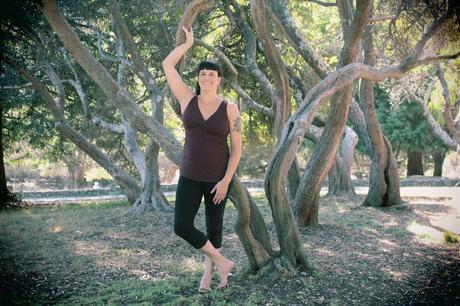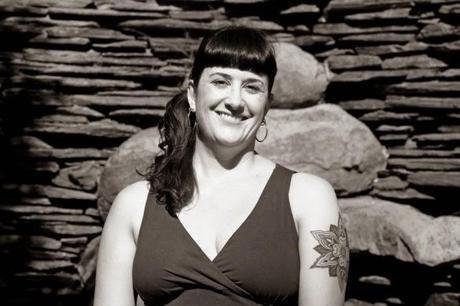by Nina

Cheryl Fenner Brown by Melina Meza
It's a bit dangerous when I actually leave the house and attend a yoga event of some sort. Inevitably I start talking with a yoga teacher who is doing something really interesting, and I start pitching the idea of a guest post or interview on their area of expertise for the blog. Yep, I'm like that—relentless. Recently, I recently ran into a old yoga friend, Cheryl Fenner Brown, who I hadn't seen in several years—we used to practice teaching each other back in the days when we were training to be teachers—and found out about the wonderful work she's doing on yoga for cancer. As usual I made my pitch, and here's the result.Nina: Tell us a little about yourself and how you got started teaching students with cancer.
Cheryl: I came to yoga in 2001 as a stressed out software trainer and gym junkie. After sitting at a computer all day I would rush to the gym and jump on the cardio machines with a book in my hand, music in my headphones, and usually a TV going somewhere nearby. Multitasking was so ingrained in my workday that it infused my workouts as well. The first time I took yoga and was asked to do one posture and breathe, it opened up my eyes to the freedom within slowing down and focusing on one thing. It wasn’t long until I dreamed of blending my work in teaching adults with my new-found love for the yoga practice, and in 2004 I started the Advanced Studies Program at Piedmont Yoga Studio.
After the 18-month program I still had so many questions, especially about how certain types of postures affect our emotions and energy. I was always asking, “Why do backbends make us feel happy and forward bends create calm?” I soon realized that more training was in store, and I enrolled in the Integrative Yoga Therapy’s Professional Yoga Therapists program first at Mt. Madonna and then at Kripalu in Massachusetts in 2007. The following year I was approached by Piedmont Yoga Studio to begin teaching a class for cancer patients, and the Living with Cancer program began with financial sponsorship by the Piedmont Yoga Community, a 501c3 organization that brings yoga to people with challenges. I continued to give classes at several other area yoga studios but I realized that I needed to connect with a cancer support group who could direct students into the classes. Then, in 2011 a student connected me with the Cancer Support Community of Walnut Creek, and I now teach two weekly classes and a monthly Yoga Nidra class at their location.
As I have continued to teach students with cancer and learned about how deeply this disease affects both my students themselves and their families, I have been humbled by the strength and perseverance I see on a daily basis. Also, I became a satellite caregiver to my father after he was diagnosed with cancer in 2010 and have now lost many friends and students to the disease over the years. I am honored to be able to show these people simple ways in which they can gain back some peace and comfort as they go through this life-changing process. It is truly empowering to witness.
Nina: Why do you think yoga particularly helpful for people with this disease?
Cheryl: When someone receives a cancer diagnosis, their whole world is turned upside down. Treatment decisions can seem overwhelming, and it is more important than ever to tap into the grounding and healing power that a simple, consistent yoga practice can provide. Then, when treatment begins, there are many side effects that can make recovery quite difficult. Often students complain of fatigue, pain, anxiety, insomnia, digestive issues, reduced cognitive function, neuropathy and lymphedema. Yoga asana, pranayama, mudra and yoga nidra are all helpful tools that can bring balance to the body, ease to the mind, and calm to the emotions.
For the past three years I have conducted research into how these yogic practices may help to reduce the side effects of cancer treatment at the Cancer Support Community. I have gathered some very promising results this year, especially with increasing spiritual and emotional wellbeing. And the latest project is currently underway. You can read more about the project on my website. Research subjects are currently being accepted into the spring 2015 session, so if you or someone you know is interested, contact me at [email protected].
Nina: Do you have any poses and practices do you especially recommend?
Cheryl: Yes, I recommend a very slow-paced combination of gentle movements that will stimulate the lymphatic system, which aids the immune system in distributing immune cells throughout the body. Simple movements such as Cat/Cow pose, lateral bends, and twists can be done lying, sitting, kneeling, or even standing so that students can practice with as much or as little activity as they require on any particular day. Calming and cooling pranayama, such as nadi shodhana, and rechaka kumbhaka, are helpful for reducing anxiety and creating a sense of calm. I also incorporate mudras or hand gestures into my classes because they can affect change in the energy, mood, and awareness of the practitioner. Mudras are simple and can be viewed almost like a yoga medicine cabinet; there is a mudra to help almost any physical, emotiona,l or energetic complaint. Restorative practice is also a perfect way to practice during treatment, especially on the days when there is the intense fatigue from chemotherapy and radiation. And, finally, I would recommend yoga nidra, a special form of guided meditation that is profoundly restful and rejuvenating. I have published several yoga nidra CDs that can be purchased or downloaded from my website.
Nina: Anything that should be avoided?
Cheryl: I would not recommend any intense form of asana practice, such as Vinyasa, Ashtanga, or Bikram, nor would I recommend deep, intense twists, backbends, or inversions. Overheating the body is not advised because traditional western medical treatments create residual heat in the body so the best practices are those that cool, soothe, and calm the body and nervous system. After treatment has ended, students can begin to incorporate more active practices as long as they are comfortable.
Nina: For people with cancer and want to get started practicing yoga, what do you recommend?
Cheryl: Look for a yoga teacher or yoga therapist who has experience teaching cancer patients, and don’t be shy about telling your teacher that you are undergoing treatment or if you have recently had surgery. Find a class that is billed as gentle yoga or restorative yoga. There may also be cancer support facilities or hospital classes in your area that specialize in yoga for cancer patients, so look around for classes designed specifically for those living with or recovering from cancer.
If you’re in the San Francisco Bay Area, I teach public classes in Oakland and Walnut Creek and also make house calls for private yoga therapy. My schedule is online here.
Nina: And for teachers who want to teach people with cancer, what do you recommend for special training?
Cheryl: I would recommend additional training in yoga therapy or specific training in yoga for cancer patients. There are many great programs out there all over the country. I personally offer a six-month mentorship for 200-hour certified teachers who are interested in working with cancer patients. The mentorship involves attending and assisting one weekly class and three teaching assignments. I am currently accepting applications into the 2015 Yoga for Cancer Mentorship, and you can find out more on my web site. I also teach a weekend intensive Yoga for Cancer teacher training module through the Niroga Institute in May of 2015. You can register directly with them at niroga.org.
Nina: Thanks for taking the time to share all this with us, Cheryl. Your work is inspiring!

Courtesy of Melina Meza
Cheryl Fenner Brown, PYT has trained with master teachers from Piedmont Yoga Studio and the Integrative Yoga therapy schools, and she blends both traditional Hatha teachings and alignment principles with subtle energy work and healing. Students appreciate her unique blend of philosophy, asana, mudra, chanting, pranayama, and yoga nidra delivered with compassion and humor. Cheryl encourages each student to honor where they are in their bodies every time they step onto the mat so deep healing and transformation takes place.With over 420 client hours as a yoga therapist, Cheryl sees clients privately and has taught over 3000 public classes and workshops in studios and cancer centers around the San Francisco Bay Area. She serves on the faculty of the Niroga Institute's Yoga Therapy 800-hour and Piedmont Yoga Studio's 300-hour teacher training programs, and offers workshops and retreats for cancer survivors. She also conducts research on the benefits of yoga for reducing side effects of cancer. For more information about Cheryl, see her web site www.yogacheryl.com. To contact her, email her at: [email protected].
Subscribe to Yoga for Healthy Aging by Email ° Follow Yoga for Healthy Aging on Facebook ° Join this site with Google Friend Connect

